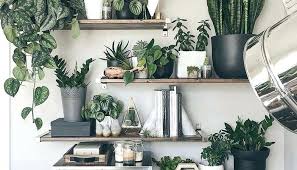BRING ON THE GREEN
Posted by Deirdre | Filed under Blog
Greenery is growing, and in a living room near you.
“Decorating with plants is definitely big, an offshoot of the boho mid-century look seen in interiors right now,” says Vancouver florist Gloria Cheung.
Aerated wall planters, living walls, hanging plants, indoor gardens and terrariums are just some of the ways Canadians are bringing life into their homes right now, and just in time to counter the deadening effects of winter.
Easy-to-care for plants like succulents, cacti or soil-less air plants requiring next to no watering make indoor gardening easy, especially for beginners.
“We all live such busy lives,” continues the co-owner and lead designer of the Flower Factory floral studio in Vancouver. “Some of the new varieties of air plants are so textured and intricate. It’s nice to know they are low maintenance, too.”
Benoit Godin, proprietor of plant design firm Vertuose Inc. in Montreal, cites the runway as a catalyst driving the decorating with-plants trend, his reference being Karl Lagerfeld’s garden themed show for Chanel in 2015.
He believes it’s why plant decor is trending at Maison et Objet, the hugely influential lifestyle, decor and design show held biannually in Paris.
“So we know that plants are on the books,” Godin says. “It’s not just a seasonal trend. It’s here to stay.”
But beyond being fashionable, decorating with plants satisfies a primal need.
“Reintegrating greenery into decor is about wanting to feel a connection to nature. It restores a sense of balance, especially in cities where office buildings and condos dominate the landscape,” Godin adds.
“Filling the home with plants is bringing life back into the indoors, surrounding ourselves with things that are living when everything on the outside, with the arrival of winter, is dead.”
Informing customers about the therapeutic properties of plants is a large component of how Alexander Chan spends much of his day.
The owner of Plant Decor in Markham, Ont., says the bulk of his online and retail business is driven by customers seeking natural solutions to the problem of indoor pollutants, for instance, and the stresses of contemporary urban life.
Among the plants he sells are fern-like bamboo palms, shiny-leaf peace lilies and sculptural spider plants, air-purifiers that Chan says work better than HEPA filtration machines.
“Indoor plant gardening is no longer an activity for retirees or seniors. With current trends in health, wellness and environmental sustainability, younger generations – particularly millennials – are becoming more and more interested in growing houseplants in their homes and offices. Being ‘green’ is something young people strive for. And the idea that plants can help purify the air and create a more natural indoor environment has made indoor gardening very attractive,” Chan says.
To ensure customers are getting the right plants for their wants and needs, Chan offers free plant decorating consultations for homeowners and corporations, the latter becoming increasingly popular as a result of studies that show a correlation between office plants and increased levels of employee contentment and worker productivity.
“Basically what I do is I send a consultant to the site who can then make plant suggestions after assessing the available light and growing conditions in the space,” Chan says. “We also accommodate feng shui and air-purifying requests for people wanting to decorate with plants in the home to optimize flow, energy and air quality.”
So how to incorporate feng shui principles into decorating with plants? The key is to see plants not as separate from furniture but as integral to the decor.
“To me, plants and florals are like the frosting on a cake, or that added element of art in a room that completely elevates a room,” Flower Factory’s Cheung says.
But the trend in indoor plants is not to over-design the look. Think minimal in terms of colour, type of plant and container, the experts say.
And think of how to make a dramatic statement with less rather than more.
Fulfilling both requirements is Ficus lyrata, the scientific name for the aforementioned fiddle-leaf fig, whose overwhelming popularity right now (sorry, pothos) is thanks to glowing editorials in Architectural Digest and Elle Decor and its status as the “unofficial official plant” of French luxury brand Céline, according to The New York Times.
Plant Decor carries the tree, whose thin trunk and big, lush leaves work well in most decors.
“It’s a large and beautiful plant,” Chan says. “It flies off the shelves like crazy.”




